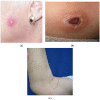Underestimation of Human Cutaneous Leishmaniasis Caused by Leishmania infantum in an Endemic Area of the Mediterranean Basin (Balearic Islands)
- PMID: 36677419
- PMCID: PMC9867513
- DOI: 10.3390/microorganisms11010126
Underestimation of Human Cutaneous Leishmaniasis Caused by Leishmania infantum in an Endemic Area of the Mediterranean Basin (Balearic Islands)
Abstract
Leishmaniasis is an infectious zoonotic disease caused by protozoan parasites of the genus Leishmania. In the Mediterranean basin, leishmaniasis is caused by Leishmania infantum and transmitted by bites of sandflies of the genus Phlebotomus, with the dog as the main reservoir host. The most common form is cutaneous leishmaniasis (CL), although visceral cases also occur. The aim of this study was to assess the underestimation of CL in an endemic Mediterranean region. Thus, a retrospective study was performed on all CL cases diagnosed and treated in the Dermatology Service of Manacor Hospital (Majorca, Balearic Islands), and the data obtained were compared with those of local government epidemiological bulletins for the same period. The different clinical presentations were compiled, and data related to sex, age, and lesion type and number were analyzed. The results reveal a clear sub-notification, which indicates that the real incidence of human CL in this area is unknown.
Keywords: Leishmania; Majorca; cutaneous leishmaniasis; subnotification of cases.
Conflict of interest statement
The authors declare no conflict of interest.
Figures
References
-
- World Health Organization Leishmaniasis. Fact Sheets. 2020. [(accessed on 15 December 2022)]. Available online: https://www.who.int/news-room/fact-sheets/detail/leishmaniasis.
-
- Berriatua E., Jumakanova Z., Muñoz C., Ortuño M., Pérez-Cutillas P., Monge-Maillo B., Conceição C., Maia C., Pereira A., Rocha R., et al. Surveillance, Prevention and Control of Leishmaniases in the European Union and Its Neighbouring Countries. ECDC; Stockholm, Sweden: 2022.
-
- Fernández Martínez B., Gómez Barroso D., Cano Portero R. La leishmaniasis en España: Evolución de los casos notificados a la Red Nacional de Vigilancia Epidemiológica desde 2005 a 2017 y resultados de la vigilancia de 2014 a 2017. Boletín Epidemiológico Sem. 2019;27:15–27.
-
- Instituto Nacional de Estadística. [(accessed on 15 December 2022)]. Available online: https://www.ine.es/jaxiT3/Datos.htm?t=2852.
-
- Xarxa de Vigilància Epidemiològica de les Illes Balears. Informe 2014. 2015, 1–116. [(accessed on 15 December 2022)]. Available online: https://www.caib.es/sites/epidemiologia/es/informes_anuales-11681/
LinkOut - more resources
Full Text Sources


